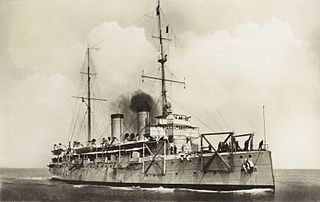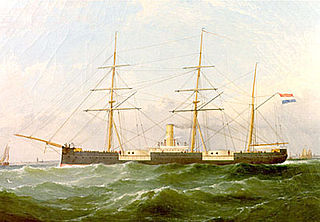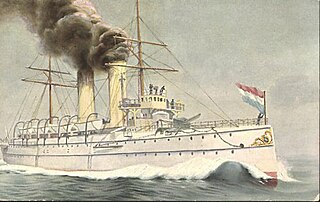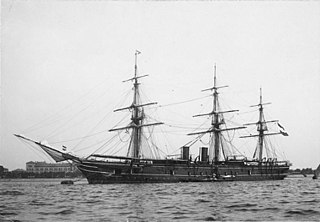
HNLMS Gelderland was a Holland-class protected cruiser of the Royal Netherlands Navy. During its career in the Dutch Navy it was most notable for being the ship Queen Wilhelmina sent to Portuguese East Africa to transport Paul Kruger to Europe during the Second Boer War. The ship was taken over by the Germans during World War II, rebuilt as an anti-aircraft cruiser and renamed Niobe. Commissioned into the German navy on 1 March 1944, she was sunk in Kotka harbour in Finland on 16 July 1944.

HNLMS Van Ghent was an Admiralen-class destroyer built for the Royal Netherlands Navy in the 1920s. The destroyer served in the Netherlands East Indies but was wrecked after running aground in 1942.

HNLMS Zuiderkruis (A832) was a replenishment oiler operated by the Royal Netherlands Navy. Zuiderkruis entered service in 1975 and was decommissioned on 10 February 2012. Her design was based on the earlier replenishment ship Poolster. The ship has been stripped for parts and left Den Helder for scrapping in Turkey on 21 February 2014.

HNLMS Prins Hendrik der Nederlanden was an ironclad ramtorenschip built in Great Britain for the Royal Netherlands Navy in the mid-1860s. She was transferred to the Dutch East Indies in 1876 and participated in the Dutch intervention in Lombok and Karangasem in 1894. The ship was hulked in 1899 and scrapped in 1925.

HNLMS Koningin Wilhelmina der Nederlanden was a unique protected cruiser of the Royal Netherlands Navy built by the Rijkswerf in Amsterdam.

HNLMS Evertsen was a Evertsen-class coastal defence ship of the Royal Netherlands Navy.

HNLMS De Ruyter was a Koningin Regentes-class coastal defence ship (pantserschip) of the Royal Netherlands Navy. The ship was built by the Maatschappij voor Scheeps- en Werktuigbouw Fijenoord in Rotterdam just after the turn of the 20th century. The ship participated in two colonial expeditions in the Dutch East Indies. She made several journeys to show the flag and was finally decommissioned in 1923.

HNLMS Hertog Hendrik was a Koningin Regentes-class coastal defence ship (pantserschip) of the Royal Netherlands Navy. The ship was built at the Rijkswerf in Amsterdam at the start of the twentieth century. She was the first ship in the Dutch navy to be equipped with wireless communication. The ship took part in two expeditions to South Celebes and during the Spanish Civil War she performed convoy duties. During World War II she was captured by the invading German forces and converted into an anti-aircraft battery. After the war the ship was recovered and given back to the Netherlands, to be converted into an accommodation ship.

HNLMS Holland was a Holland-class protected cruiser of the Royal Netherlands Navy.

HNLMS Zeeland was a Holland-class protected cruiser of the Royal Netherlands Navy.

HNLMS Friesland was a Holland-class protected cruiser of the Royal Netherlands Navy.

HNLMS Utrecht was a Holland-class protected cruiser of the Royal Netherlands Navy.

HNLMS Noordbrabant was a Holland-class protected cruiser of the Royal Netherlands Navy.

HNLMS Sumatra was a Java-class cruiser of the Royal Netherlands Navy. She was launched during World War I and saw action during World War II. She was scuttled off the coast of Normandy on 9 June 1944 at Ouistreham as part of a "gooseberry" pier to protect an artificial Allied Mulberry Harbour built as part of Operation Overlord.

HNLMS Java was a Java-class cruiser of the Royal Netherlands Navy. She was sunk during the Battle of the Java Sea on 27 February 1942.

The Koetei-class was a class of three colonial schroefstoomschepen 4e klasse (gunboats) built by the Nederlandse Scheepsbouw Maatschappij in Amsterdam and Maatschappij voor Scheeps- en Werktuigbouw Fijenoord in Rotterdam for the Royal Netherlands Navy. The class comprised Koetei, Siboga and Assahan.
HNLMS Borneo was a unique schroefstoomschip 4e klasse (gunboat) of the Royal Netherlands Navy built by J&G Thomson in Clydebank Glasgow.

HNLMS Abraham van der Hulst was a ship of the Karel Doorman-class of multi-purpose frigates of the Royal Netherlands Navy where it used the radio call sign was "PAMF". Built by the shipyard Koninklijke Schelde Groep in Vlissingen. The ship is named after the Dutch Admiral Abraham van der Hulst. She was sold to the Chilean Navy where the ship was renamed Almirante Blanco Encalada.

HNLMS Van Nes is a ship of the Karel Doorman class of multi-purpose frigates of the Royal Netherlands Navy where it used the radio call sign was "PAMI". Built by the shipyard Koninklijke Schelde Groep in Vlissingen. The ship is named after the Dutch Admiral Aert Jansse van Nes. She was sold to the Portuguese Navy where the ship was renamed NRP Bartolomeu Dias.

HNLMS Atjeh, was an Atjeh-class unprotected cruiser built at the Rijkswerf Amsterdam for the Royal Netherlands Navy. The ship served three term in the Dutch East Indies and was rebuilt as accommodation ship in 1906.



















